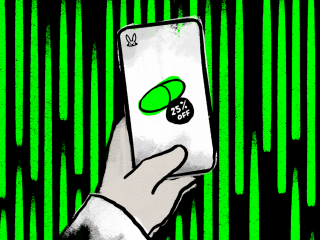Gen Z now accounts for over 32% of the world’s population.
Millennials count for 23%.
Together, their combined spending power in the United States alone amounts to £264 billion. As a marketing agency, this is the kind of statistic that makes us happy: it shows where the money’s coming from, and if we know where the money’s coming from, then we can make better stories. Better stories mean more people listen to those stories. If more people listen, we get the opportunity to make more stories.
But there’s a caveat. To tell the stories that make a difference, you need to know what your audience is – and Gen Z and Millennials are not the kind of audience that’s easy to understand.
Gen Z and Millennials: An Audience Profile
Here’s what we know:
They’re fiercely dedicated to their causes: 72% of Gen Z will only buy from brands that support societal causes. 83% of millennials do the same.
They’re sale-and-money conscious. These are people who grew up in the heart of multiple catastrophic events: 9/11, two recessions, unending war, climate change, and a global pandemic. Money has always been a problem, and it’s not a problem that’s going to end soon.
They’re kind. Millennials and Gen Z especially know what it’s like to struggle to make rent, to pinch pennies to pay vet bills, and to face the uncertainty of living from paycheck to paycheck. GoFundMes, Kickstarters, and circulating payments are one of the cornerstones of their existence.
They’re digital geniuses. The oldest millennial remembers the start of the internet age. The oldest Gen Zer doesn’t remember anything but.
All those combined, and you have an audience that knows that your communication has a purpose, and that purpose is to sell them things they will not necessarily need. That makes them resistant to most forms of advertising that can’t stand up to fact-checking – and resistant to companies that have already had problems in their past with their message, or their values.
Marketing to a millennial and Gen Z audience also isn’t something that can be avoided. With most of the purchasing power now firmly in the hands of both demographics, it isn’t a case of ‘well, we’ll talk to someone else’.
There’s no-one else. It’s millennials and gen Z all the way down.
Marketing to the Unmarketable
Here’s the thing: marketing to Gen Z and Millennials needs more finesse than regular marketing. It’s the difference between having a conversation with an expert in your field and getting into an argument with someone on Facebook: one is ultimately futile, and the other can open up connections and nuances that weren’t there before.
We’ll leave you to decide which one of those that is for you.
For Gen Z and millennial marketing, there’s three important factors to remember.
1. Social is key
When everything costs money and money is a premium product, you turn to the one thing that’s still free: social media. Gen Z and Millennials spend a combined total of five and a half hours a day on social media, though with the pandemic, that amount has skyrocketed up by about 36%.
The takeaway: don’t spend time advertising on channels where your message isn’t going to be seen. We’ve been talking for a while about how digital is the way forward, but it’s especially crucial now when the people who you’re marketing to live, breathe, and play on digital. Facebook, Instagram, Twitter, TikTok: social media has become the medium for the message.
If that isn’t convincing enough, consider this: 75% of millennials are directly influenced by a brand’s social media when it comes to making purchasing decisions.
2. Honesty is the best policy
Make sure your values are in line with your company’s promises because Gen Z and Millennials can, and will, find out.
For millennials and Gen Z, supporting a brand is a moral choice, not just monetary; it’s a crucial aspect of making a decision to buy from that brand. If you have a message that supports an agenda, if your values are clearly communicated, then Gen Z and millennials will find a way to buy from that brand. Being honest about your limitations and flaws help. Social responsibility helps.
The takeaway: build up your community responsibility measures. Find a way of having conversations online that matter. Support a cause. Stand by the cause you support. Be braver and take risks. Brands that stand by and pretend to be above the conversation going on are no longer the main conversationalists at the table.
Brands that talk are.
3. Create, and keep, loyalty.
What we said above, times ten.
Look: part of the inherent risk that comes with supporting a new brand is that you don’t know if you’re going to enjoy whatever that brand puts out. If it’s a big purchase, it matters more; a small purchase of a few Euro off of Aliexpress doesn’t hold the same gravitas.
However, Gen Z and Millennials count every purchase as a big purchase, and put thought behind it all. If a brand puts out a product they’d like to try, but it’s above a certain budget, it’s difficult to get them to buy in initially. Why would they? Lots of risk for a potentially low reward does not a happy shopper make.
Consider clothing stores.
Retail stores took a big dip during the early days of the pandemic when people could no longer try on the clothes they were going to buy. Makeup retailers saw the same side-effect: once you remove the aspect of ‘try before you buy’, making a final decision becomes that much harder.
Gen Z and Millennials won’t buy your product just because. If it’s on offer, if it’s part of a loyalty scheme, if you offer excellent after sales service: then it becomes easier. The risk is minimal. The cost pays for itself in peace of mind.
The takeaway: surprising your audience does no-one any good. Offer a way into your world at a reduce cost – think long-term financial pay off instead of short-term. A buyer who’s happy with your service will keep you front-of-mind for subsequent purchases, and if they already have that experience, it’s easier to keep going back to the devil you know.
A handful of ideas
Easier said than done? Maybe. But it’s not an impossible task for any brand.
And it always goes back to brand.
Gen Z and Millennials aren’t going to support a brand they don’t agree with, that’s dated, or that supports something they don’t support. However, before you go and throw the whole company away, think.
Who do you want to be?
What do you support?
What do you think?
Brands are extensions of the people that work in them, the people that create them, and the decisions they make.
Brands are also, fundamentally, inherently, and obviously, changeable. While changing a whole company to attract one audience isn’t going to make any sense, neither is holding onto a past no-one wants to relive.
If you’ve tried all that, and it still isn’t working, you’ve missed something somewhere.
Maybe it’s time to try something new.




